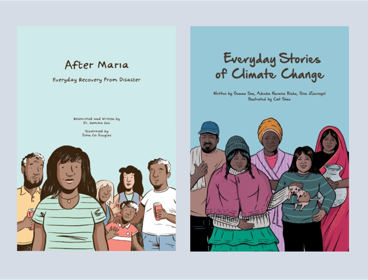By Alastair Bonnett, Newcastle University
The world wants to hear from you. Getting your message across to wider publics has never been more important and there is a huge appetite for stories about geography. But it is not enough to sit and wait for the phone to ring. If you want to expand your audience you have to make it happen. This means pitching ideas but also learning how to write stuff that people want to read.
There are many forms of public dissemination and any of them can work for you. It is helpful to be clear what your aims are and be realistic about them. Although there is a growing appetite amongst commercial publishers for geography, in my experience writing a ‘trade' book is more work than writing an academic monograph (I have done both). The revision and proofing process is exhaustive and exhausting. Few academics and would-be academics have the time to devote themselves to producing ‘trade’ books, especially once they learn that, irrespective of the sweat poured into them, they are not eligible for submission to research assessment exercises.
Your most useful and realistic aim is not a best seller but to get media coverage for your work. Many universities have press offices that can give advice and can help you draw up a ‘press release’. These are statements directed at the press, announcing significant findings or outputs. However, many press releases do not lead to press coverage. To get things moving you need to learn the art of the pitch. A pitch consists of three things: an editor who you are pitching to; a title, and a very short (one, two, or three sentences) outline. All three of these ducks need to be lined up for a pitch to work. It is often more productive to pitch to specific, named editors than to write to a general email address. Local newspapers, radio stations, blogs, and specialist magazines and websites are often more responsive than mainstream national outlets. This is especially so in countries such as the UK, where ‘big media’ is highly centralised, politicised, and insular, offering relatively few opportunities for meaningful input from outsiders. A specific health warning has to be issued in respect to British national newspapers. Professional standards on the ‘London papers’ are notoriously low, and political hostility and shock value determine content. There are, thankfully, many other outlets for your work and a growing and eager audience for geography.
The four words that will help you navigate this, sometimes daunting, landscape are concision, clarity, timeliness, and persistence. Let’s start with the last. Newspaper and website editors have an effective way of responding to pitches that they are not interested in. They don’t. You can send a pitch to twenty different outlets and the reaction may be zilch: your hopeful inbox looking as unpopulated as the surface of the Moon. Don’t take it personally; rebuffs are part of the process. You do need to learn from them though; to recalibrate, take a break, and come again with a different story or angle.
Often pitches don’t work because of timing. In order to get interest in a piece it has to be ‘of the moment’ and interesting. Being ‘of the moment’ can be as simple as pitching around an anniversary. For example, ‘this year is the fiftieth anniversary of “Science City”’. The date creates a hook to peg an article on.
Your title needs to be straightforward but intriguing. For example, ‘What’s Wrong with ‘Science City’? Fifty Years of Failure?’. The topic and the angle are clear and upfront. The title should be followed up with a short outline, which can also be used to explain why you are the right person to be writing this piece. ‘As one of the founders of Science City’; ‘having worked in Science City’: these are the sort of catches that establish why you are a plausible ‘go-to’ for this story.
If you get any sort of response, then the door is open and you need to think about how to write your piece. You are not writing an academic article. There will be no references; no jargon; and as few ‘isms’ as possible. Academic papers are often written with no regard for flow or style. In some ways ‘academic writing’ is simply bad writing; though it is fairer to think of it as a specialist dialect, arising from a language community with its own distinct heritage and purpose.
Communicating with wider audiences means knowing how to tell an engaging story. You have to think about pace, imagery, and the arc of your narrative. Starting with an engaging image can be a helpful device and so too can personal anecdote and, more generally, use - but not overuse - of a personal voice. Slightly eccentric detail and humour can also be effective, though they also work best in moderation. Writing that has punch and rhythm often uses short sentences, followed by a longer one and makes use of alliteration, and thoughtfully chosen but ‘unfancy’ adjectives, verbs, and adverbs. Reading your work out aloud can help with this: good writing sounds good to the ear.
Above all, good stories are not boring. No one wants to listen to a story told in a tedious or patronising manner: ‘this is important; that is important; I’ve got a PhD so I’m important’. Don’t make the mistake of thinking that, since your story was accepted, at least in part because of your academic credentials, readers want to read ‘an academic account’. Another mistake is to construe what you are doing as ‘dumbing down’. It’s not lesser; but it is different. And it requires skills that need to be practiced and honed, so that your work finds the diverse audiences it deserves.
How to cite
Bonnett, A. (2023) Writing for general audiences. Communicating research beyond the academy. Royal Geographical Society (with IBG) Guide. Available at: https://doi.org/10.55203/ZYNN5056
About this guide
There’s a long tradition of geographers communicating research ‘beyond the academy’ - to policy, to publics, to young people, to school teachers - whether to recruit students, for career development, critical praxis and activism, or requirements of funders to document ‘impact’. Ten years ago we published the Communicating Geographical Research Beyond the Academy guide. It sought to bring together and share collective experience and learning, from within and beyond the academy. Today, there’s ever more opportunities and modes and media with which to do this. While many of the points made – about audience, about access, about brevity and the use of plain English – still stand, this collection covers these already familiar issues as well as bringing new perspectives to encourage readers to reflect on motives, means and methods and to illuminate examples of good practice.




